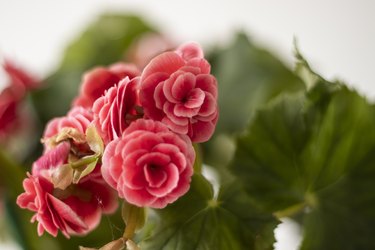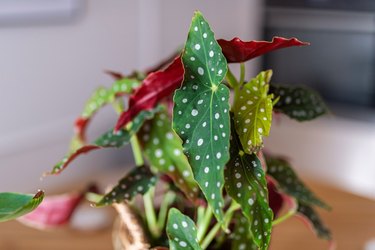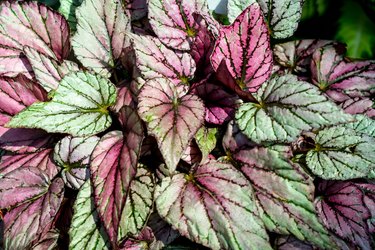
Begonias are plants that are members of an extremely popular plant family (Begoniaceae) that offer endless options to gardeners and homeowners. Some types of begonia like sun, while some require shade. Some are short, and some are tall. Some are grown for stunning foliage, while others are grown for bright blossoms. Although many people expect the fascinating begonia to be delicate and difficult, a great many types are easy to grow. In fact, because begonia care can be so simple, most types are excellent plants for beginners as long as you follow a few simple guidelines.
If you are ready to start growing begonias, read up on the different types, decide which fit your space, plant them appropriately, and then offer them top begonia care. Here's all the information you'll need.
Video of the Day
Meet the Begonia Family
Begonia is a genus with thousands of species and cultivars, including annual plants, perennials, garden shrubs, and climbers. They are characterized by fleshy stems and showy flowers and leaves in unusual shades and shapes. Begonias are popular houseplants as well as landscape plants. The sizes, shapes, and color patterns are endless, which makes the selection process challenging.
The easiest way to get on top of the "which begonia to plant" issue is to read up on the characteristics of the five main types of begonias. Each one has its own ornamental features and needs different begonia care.
Types of Begonias
Every type of begonia is the "best begonia" for certain circumstances. That's why anyone wishing to bring a begonia into the home or landscape needs to understand the main types: wax; tuberous; cane/angel wing; rhizomatous; and rex, a subcategory of rhizomatous begonias.
Wax Begonias (Begonia semperflorens)

Also known as fibrous begonias because of their fibrous roots, these short, compact plants offer the most blooms of any begonia. Prized for their mounding, waxy leaves and jewel-colored blossoms, they are among the most popular members of the begonia family. These are landscape plants, usually purchased in spring and grown for one season only as bedding annuals, where they grow quickly, filling in bare spots in the garden. They also look good in containers and hanging baskets. You can find them in a wide range of colors, including yellows, pinks, and reds.
Tuberous Begonias (Begonia x tuberhybrida)

These begonias are taller than wax begonias — up to 36 inches outdoors — and come in two plant forms: upright or trailing. Their thick tubers store water and nutrients. Though they have attractive green or burgundy leaves, they are generally grown for their bright, jewel-toned summer flowers that look like camellias. You can find plants that bloom in almost every color of the rainbow (but no blues or purples), and they have single, double, or ruffled flowers. Growing from tubers rather than rhizomes, they are said to be the most spectacular bloomers of the begonias.
Cane Begonias (Begonia x corallina)

Cane begonias are evergreen perennials that grow upright with segmented stems (like bamboo) and astonishing foliage. These cane types have beautiful foliage and bloom in a wide array of colors. The initial green-leaved cane varieties had leaves shaped like wings and were called angel wing begonias. This name is now used for all cane types, including the polka dot begonia (Begonia maculata), a popular cane variety. These plants are purchased as houseplants but are also occasionally used as landscape plants in warm areas. They can grow up to 60 inches tall outdoors under excellent growing conditions, but they don't grow taller than 12 inches as houseplants.
Rhizomatous Begonias
These are foliage begonias, grown for large, colorful leaves that sprout from thickened roots called rhizomes. This begonia group produces compact foliage with a mounding habit and large, often colorful leaves. Flowers are white or pink, but hundreds of species and cultivars exist with different shades available.
Rex Begonias (Begonia rex-cultorum)

Rex begonias are actually a subgroup of rhizomatous begonias and grow from a rhizome, but they are classified separately. Extremely popular houseplants, they are beloved for their magical and gorgeous foliage, which is said to be the most impressive of all types of begonia. The leaves range widely in shape, texture, and color. The flowers are insignificant compared to the foliage.
Types of Begonias
Type | USDA Zones | Height | Location | Ornamental Interest | Exposure |
|---|---|---|---|---|---|
Wax | 9-11 | 6-12 inches | Outdoors as annuals, sometimes houseplants | Prolific single or double flowers | Sun or light shade |
Tuberous | 6-9 (Begonia grandis) 9-11 (others) | 36 inches outdoors, 18 inches indoors | Outdoors and as houseplants | Brilliantly colored flowers | Shade with some morning sun |
Cane | 10-11 | 60 inches outdoors, 12 inches indoors | Houseplants and sometimes outdoors | Stunning foliage and/or bright flowers | Partial shade for foliage, indirect light for flowers |
Rhizomatous | 10-12 | 2 - 36 inches depending on variety | Houseplants and outdoors | Attractive, showy foliage | Part to full shade outside, bright indirect light indoors |
Rex | 10-12 | 18 inches tall and wide | Houseplants | Foliage plant | Bright indirect sun |
Complete Begonia Care Instructions
The wide variety of bright flower hues and intricate leaf shapes and designs might lead you to believe that begonias are prima donnas when it comes to care, but that is not true at all for most types of begonias. These eye-catching plants are generally easy to grow whether in the garden bed or outdoors. The key to begonia care is to pick the right plant for your region and for the particular placement. Each begonia type has slightly different requirements, and cultural care will vary depending on whether they are sited inside or outside.
Wax Begonia Care Outdoors
Wax Begonias: Sun or Shade?
It depends on climate and type of wax begonia. Plant wax begonias that have reddish-bronze leaves in a full-sun location (these have relatively good hot sun tolerance), and plant wax begonias that have green leaves where they receive some morning sun but afternoon shade.
Wax Begonia Soil Type
The soil should be well-draining but also moist and rich in organic material.
Wax Begonia Water
Begonia care requires irrigation. Water landscape plants regularly, trying not to get water on the leaves. The ideal is to keep the soil moist but not wet. It helps to apply a few inches of organic mulch on the soil to keep in moisture.
Wax Begonia Humidity
These plants hail from warmer regions of Central and South America and are not very cold hardy. They love humidity and warmth, so don't plant them until temperatures reach 60 degrees Fahrenheit and higher.
Wax Begonia Fertilizer
Begonias do not need extensive nutrients to thrive. If you want to fertilize, dose them monthly with a mild general fertilizer (10-10-10) during the growing season or apply organic granular fertilizer at planting time to last the entire season.
Wax Begonia Pruning
No major pruning is required. These plants continue blooming regardless of whether you deadhead them, but you may need to pinch back stems if the plants become leggy. Doing this will promote new growth and lots more flowers.
Wax Begonia Problems
If the soil doesn't drain well, these plants will get root rot and can die quickly. Begonias are also vulnerable to powdery mildew, mealybugs, spider mites, thrips, and whiteflies.
Wax Begonia Care Indoors
The same general growing instructions apply, with just a few modifications. Indoor wax begonias with green leaves require bright but filtered sunlight, while those with bronze leaves should be sited where they receive as much direct sun as possible.
Getting the drainage and irrigation correct is a matter of using well-draining potting mix and watering at the base of the plant. Allow the potting mix of indoor plants to dry slightly before watering again.
Provide indoor wax begonias with humidity by placing the containers on a pebble tray with water.
Tuberous Begonias Outdoors
Tuberous Begonias: Sun or Shade?
These begonias love shade but need a little sun. Plant them in a shady area in the landscape that gets morning sun or dappled sun in the afternoon.
Tuberous Begonia Soil Type
The soil should be well-draining but rich in organic material.
Tuberous Begonia Water
Tuberous begonia care requires regular irrigation, but it's important not to keep the soil soggy or the tubers will rot. Water landscape plants regularly, trying not to get the water on the leaves. These begonias require fairly frequent watering, sometimes every day or two during the hot days of summer but only if the soil becomes dry. The ideal is to keep the soil moist but not wet. It helps to apply a few inches of organic mulch on the soil to keep in moisture. These begonias die back every fall, so cut back on water in early fall.
Tuberous Begonia Humidity
These plants hail from warmer regions of Central and South America and are not very cold hardy. They love humidity and warmth, so don't plant them until temperatures reach 60 degrees Fahrenheit and higher.
Tuberous Begonia Fertilizer
Tuberous begonias are heavy feeders since they bloom all season long. They require an application of diluted balanced liquid fertilizer every week to two weeks throughout the growing season. Cut out the fertilizer in early fall.
Tuberous Begonia Pruning
No major pruning is required. Don't bother deadheading, as the plants naturally drop their spent blossoms. Prune back foliage when it starts to yellow in fall. Dig up the tubers before the first frost. If you're growing hardy begonia (Begonia grandis), you can leave the tubers in the ground if you live in its perennial range across USDA hardiness zones 6 through 9.
Tuberous Begonia Problems
Tuberous begonias have serious rot issues if their water and soil needs are not met. If given too much water, they are susceptible to stem rot, powdery mildew, and botrytis blight. They are also vulnerable to mealybugs, whiteflies, and aphids but are for the most part deer- and rabbit-resistant.
Tuberous Begonia Care Indoors
Although tuberous begonias can be grown as houseplants, these plants are hard to grow as houseplants since they require more humidity and water. Experts recommend that you do not grow these plants indoors.
Cane/Angel Wing Begonias Care Outdoors
Cane Begonias: Sun or Shade?
Cane begonias can be grown for their foliage or their flowers. If you are looking only for the gorgeous leaves, plant it in partial shade. If you want flowers, look for an area with indirect but fairly bright sun.
Cane Begonia Soil Type
Like other begonia varieties, cane begonias need organically rich, moist soil with excellent drainage.
Cane Begonia Water
Begonias need water, and cane begonias need more than a little. Remember that their thick, bamboolike stems hold a lot of water. Plants like angel wings and polka dot begonias grow best when their soil is kept moist all of the time. If you neglect this requirement, the edges of their leaves will crisp. It helps to apply a few inches of organic mulch on the soil to keep in moisture.
Cane Begonia Humidity
These plants do best in a warm, humid climate. If this does not describe your summers, it is better to bring the plants indoors where you can spray them and keep them warm. They may die if the thermometer dips below 50 degrees.
Cane Begonia Fertilizer
Cane begonias flower best with regular fertilizer. Use a liquid fertilizer at one-quarter strength every week. During flowering season, change to a high-phosphorous fertilizer.
Cane Begonia Pruning
No major pruning is required. Clip off dead leaves and flowers whenever you notice them.
Cane Begonia Problems
These plants are susceptible to powdery mildew, root and stem rot, mealybugs, and whiteflies.
Cane/Angel Wing Begonias Care Indoors
Cane begonias make wonderful houseplants and are generally bought for indoor use. Most of the same rules apply. These begonia houseplants like bright, indirect light year-round. Keep the house warm and use a pebble saucer or mister to provide the humidity they require. Cane begonias can grow quite tall, so you'll need to stake larger plants to prevent damage. Provide lots of water when the top inch of the soil is dry.
Rhizomatous/Rex Begonias Care Outdoors
Rhizomatous/Rex Begonias: Sun or Shade?
These begonias love shade when planted outdoors. Plant them in an area with full or partial shade.
Rhizomatous/Rex Begonia Soil Type
The soil should be well-draining but also moist and rich in organic material.
Rhizomatous/Rex Begonia Water
Rhizomatous/Rex begonia care requires regular irrigation. Water landscape plants regularly, trying not to get water on the begonia leaves. These begonias require fairly frequent watering, sometimes every day or two during the hot days of summer. The ideal is to keep the soil moist but not wet. It helps to apply a few inches of organic mulch on the soil to keep in moisture. These begonias die back every fall, so cut back on water in early fall.
Rhizomatous/Rex Begonia Humidity
These plants hail from warmer regions of Central and South America and are not very cold hardy. They love humidity and warmth, so don't plant them until temperatures reach 60 degrees Fahrenheit and higher.
Rhizomatous/Rex Begonia Fertilizer
Rhizomatous begonias are heavy feeders since many of them bloom all season long. One exception is rex begonia, which is prized for its foliage and many hybrids may not be coaxed into bloom. They require an application of diluted balanced liquid fertilizer every week to two weeks throughout the growing season. Cut out the fertilizer in early fall.
Rhizomatous/Rex Begonia Pruning
No major pruning is required. Don't bother deadheading, as the plants naturally drop their spent blossoms. Prune back foliage when it starts to yellow in fall. Dig up the rhizomes before the first frost.
Rhizomatous/Rex Begonia Problems
Rhizomatous/Rex begonias have serious rot issues if their water and soil needs are not met. If given too much water, they are susceptible to stem rot, powdery mildew, and botrytis blight. They are also vulnerable to mealybugs, whiteflies, and aphids but are for the most part deer- and rabbit-resistant.
Rhizomatous/Rex Begonias Care Indoors
Inside, these begonias thrive in east-facing windows or when set back from southern or western exposure. They need plenty of indirect sun. Temperature is very important since these begonias prefer to live where temperatures do not dip below 60 degrees even at night and stay around 70 degrees during the day. Keep the humidity level as high as possible, around 50 percent.
Care Tips for Begonias in Hanging Baskets
A hanging basket will add vibrant color to your patio area without taking up garden space. You'll want to select not just a beautiful plant but one that is also easy-care and long-flowering. Begonias are a perfect choice. Here are some tips to ensure success.
Pick an appropriate begonia species or cultivar: Try trailing tuberous perennials, like Angelique (Begonia odorata 'Angelique,' which will cascade over the sides of the basket, or Bossa Nova® red (Begonia boliviensis), which has red pendant flowers. Wax begonias are another excellent choice for hanging baskets.
Select a hanging basket with good drainage.
Fill the basket with light, well-draining potting mix.
Buy young plants at the garden store and break up the roots before putting them into the basket soil. If you're planting a tuberous or rhizomatous begonia, do not break up the roots or sever/divide the rhizome or tuber.
Don't mount the plants above the basket rim. It will make them hard to water.
Don't stuff the basket. Remember that the plants will grow and expand.
Select a protected location, like beneath a covered deck, porch, or pergola.
Don't forget to water hanging begonias regularly.
FAQs
Do begonias like full sun or shade?
Different begonias have different exposure requirements. Most begonias are shade lovers but need a little sunshine too. That means dappled shade or morning sun and afternoon shade.
Do you have to deadhead begonias?
Some types of begonias bloom better when you clip off their dying blossoms. Others, like wax and tuberous begonias, drop their dead flowers themselves and do not require deadheading.
How do you keep begonias blooming?
Different varieties of begonias bloom for different periods. Many bloom during all or most of the growing season. Indoor begonias may bloom all year long.
How long do potted begonias last?
Potted begonias can last as long as their companions planted in the soil. They might live longer since they can be brought inside in winter.
Do potted begonias come back?
Begonias that are grown as annuals last for one season only and die as winter comes on. Some types of begonias in warm climates are perennials and may grow back year after year in beds or pots. If you bring potted begonias inside during winter, they may continue growing.